Christmas in Serbia
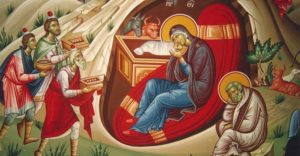
One of the main symbols of Christmas holidays for majority of people around the world is Christmas tree or decorated fir tree to be more precise. In a way Serbia is not exception, but in its’ tradition oak branch full of golden dry leaves is that Christmas tree. It is called badnjak and it’s kept in homes of Serbian families only on Christmas Eve. Some compare it rather with yule log than Christmas tree in other Christian traditions. However, that is just one of traditions that make Serbian Orthodox Christmas celebration unique.
On The Same Day… Not
Serbian Orthodox Church celebrates Christmas on December 25th, two weeks later than Catholic, Protestant, Greek Orthodox and some other confessions that have Christmas on December 25th. Sounds weird? Perhaps, but this is not a typo. This is a story about two different calendars. Serbian, Russian and few other Christian, mostly Orthodox churches follow Julian calendar, while majority of other Christians use Gregorian one. Julian calendar was proposed by Julius Caesar in 46BC and Gregorian in 1582nd by Pope Gregory XIII. During 19th and 20th century Gregorian calendar was accepted globally and nowadays it is considered as international. Different Christian and other churches still follow some other calendars when it comes to religious events and holidays. That is obviously the reason that Serbian Orthodox Church doesn’t celebrate Christmas day at the same day as majority of other Christian confessions. According to Julian calendar it is on December the 25th and according to Gregorian it is on January the 7th. Same date, different day.
Cousin Badnjak
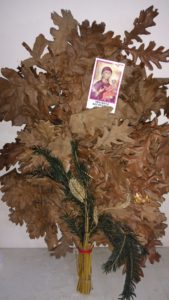 There are many holidays connected to Christmas in Serbian tradition and all of them celebrate the birth of Jesus Christ and Biblical events that precede and follow it, but also honour children, mothers, fathers, family, family ties and life in general. Central celebration starts on Christmas Eve, which is called in Serbian Badnji dan during the daylight and Badnje veče in the evening. Many customs are accompanied with Christmas Eve and they vary in some regions, but there are still general practices common for all parts of Serbia.
There are many holidays connected to Christmas in Serbian tradition and all of them celebrate the birth of Jesus Christ and Biblical events that precede and follow it, but also honour children, mothers, fathers, family, family ties and life in general. Central celebration starts on Christmas Eve, which is called in Serbian Badnji dan during the daylight and Badnje veče in the evening. Many customs are accompanied with Christmas Eve and they vary in some regions, but there are still general practices common for all parts of Serbia.
Early in the morning on Badnji dan, men go to the woods to chop the Turkey oak or some other oak tree log. Very rarely they choose some other tree, usually if there are no oaks in area. The one who chops the tree turns to east, says a prayer and kisses the tree before cutting it. There is something touching in that scene, where one shows love and respect for God and nature. Some of these customs are coming from the pre-Christian times when Serbs and other Slavic people believed that all beings and everything around us in nature and cosmos is alive and has soul and personality. After that, men take Badnjak they chopped on their shoulder and leave it in front of their house. People often make badnjak also by putting together oak branch or few of them with small bundles of wheat, twig of haw and other plants that symbolize good harvest, good health and wellbeing overall. That is how it’s done for centuries, but from obvious reasons nowadays people who live in cities take small Badnjak at local church, marketplace, supermarket or grocery store. People often make badnjak also by putting together oak branch or few of them with small bundles of wheat, twig of haw and other plants that symbolize good harvest, good health and wellbeing overall.
There are usually few other customs included in ceremony of chopping Christmas log in Serbia, but this time we are sharing with you just the main ones in order to present to you the essence and the most beautiful traditions rather than to overwhelm you with every little detail. However, there is another lovely tradition on Christmas Eve that children like very much. After Badnjak is brought into the house, one of adults in the family spread armful of straw and handful of walnuts all over living or dining room floor. While spreading it, that person is clucking as hen chicken and others follow him or her and answer by cheeping like chicks. This custom is not as common as it used to be, especially in cities, but it is still very well known among Serbs of all generations.
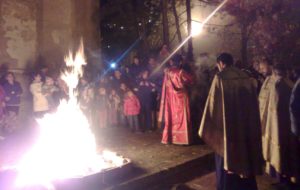
In the evening the oak log or branch is burnt in the fireplace inside or in front of the house. In some areas, especially in cities, it is burnt in churchyards and followed by small religious ceremony and socializing. The experience is perhaps more beautiful when Badnjak is burnt outdoors, because of many sparkles flying to the sky and disappearing like tiny shooting stars. Still, the essence is in celebrating with family and all loved ones and that is what makes Christmas time truly special.
Important part of Christmas Eve celebration in Serbia is also festive dinner prepared on that day. It is the last day of 40 days long Christmas fasting for Serbian Orthodox Christians and all dishes on the table are vegan. The menu varies, but usually it consists of festive bread and salt, prebranac (baked beans), ajvar (local creamy spread made of paprika, eggplants and other summer vegetables), sauerkraut, pickles and noodles with minced walnuts and honey. Grilled or roasted fish is often served too, depending how strictly family follows fasting. There is also on the table a bowl of apples, oranges and other fresh fruits, but also dried plums, figs and apricots, walnuts, hazelnuts, almonds and fruit candies on the table. Even atheists usually fast on that day in Serbia. Beautiful prayers, greetings, verses and songs are also part of the dinner, as well as of all customs connected to Serbian Christmas celebration. In some of those songs, one addresses to Badnjak as if it is a person, calling it “Badnjak cousin”. That also originates from pre-Christian times when everything around us was respected as living being with soul. It is really uplifting when people exchange so many thoughts and words of joy, happiness and kindness. That gives lovely festive vibe to Christmas Eve celebration in Serbia.
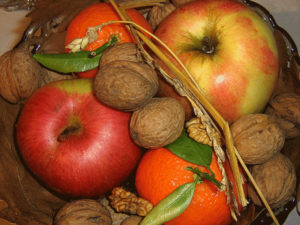
Hristos se rodi!
Christmas is called Božić in Serbian, which means a young god or baby Christ, though there are some older pre-Christian meanings attributed to this word as well. During Božić, which is celebrated three days in Serbian Orthodox Church, people greet each other saying “Hristos se rodi” and answering “Vaistinu se rodi”, which means “Christ is born – He is born indeed”. One may also just say “Srećan Božić” in a meaning “Merry Christmas”.
Sometimes the Christmas day celebration starts with festive midnight liturgy (Orthodox mass) in churches after the Christmas Eve dinner. This tradition is brought from Russia and relatively new in Serbian Orthodox Church. Not all churches have this first midnight service, but all of them do have liturgy on Christmas morning that starts usually at 9am and lasts around 2 hours. Those who were fasting have a confession and take a communion during the service. Priests wear special, festive cassocks and Christmas songs make liturgy different than usual ones. That is how Christmas Day starts for majority of Serbian people.
After the liturgy people usually go straight home to celebrate. The first guest that visits one’s home on Christmas is called radovan or položajnik. People usually prearrange who will be that first visitor, because of belief that it should be a man or a boy who has good heart and brings luck to the family for the whole year. Položajnik / radovan stays for breakfast and in some areas gets presents from his hosts.
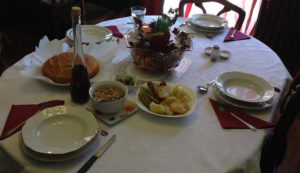
Special part of Christmas celebration is rich festive lunch, which starts with prayer and sharing česnica (special Christmas bread) to everyone who sit at the table. Usually the father of the family gently breaks česnica, puts aside pieces for home, happiness and unexpected guest and shares the rest to his family members. There are different kinds of this Christmas bread in different areas and in Vojvodina (Northern part of Serbia) it is a kind of sweet pie made with honey and minced walnuts. It is believed that the one who finds coin hidden in it will be very lucky during the whole year. On Christmas day in the centre of table there is usually little flowerpot with wheat grass, lighted candle in the middle of it and red ribbon wrapped around it. The wheat grass symbolizes good harvest for that year. Christmas lunch is very rich and there are various different dishes on the table. Cold starters are not always the same, but it’s usually prosciutto, ham, sausages, different kinds of cheeses and Serbian traditional pies. As a warm starter there is usually sarma (stuffed sour cabbage leaves) and as the main course pork roast, roasted potatoes, coleslaw and other seasonal salads. For dessert there are different tasty cakes and sweet pastries. Traditional plum schnapps šljivovica (slivovitz), wine, mulled brandy (again usually slivovitz) or mulled wine are the most common drinks for Christmas lunch. Toasts and songs make the Christmas celebration truly beautiful and heart-warming.
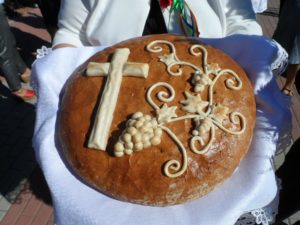
Peace on Earth
There are many ancient customs that make Christmas time in Serbia unique, but the essence is the same everywhere as well as some traditions. Decorated fir tree is also common in Serbia, though it’s not local tradition. It came from Western Europe and Russia in 19th century and during 20th century it became widespread in Serbia, but Serbian people usually call it New Year Tree and put presents bellow it on New Year’s Eve. Regarding New Year’s Eve, nowadays people in Serbia celebrate both Gregorian on December 31st and Julian on January 13th. Similarities as well as differences are beautiful and make every country, every nation and every person on our amazing planet unique, authentic and connected at the same time. That is what makes Christmas and life in general so exciting and colourful. Celebrating our differences and similarities is a great foundation for peace among all people of the world. Peace in every meaning of that word is one of the greatest values of Christmas too. No wonder that the longer version of Serbian Christmas greeting is “Peace of God! Christ is born!” or originally “Mir Božiji! Hristos se rodi!”
Australiana Serbahttps://www.australianaserba.com/christmas-in-serbia/https://www.australianaserba.com/wp-content/uploads/2017/01/Bozicni-post-720-1.jpghttps://www.australianaserba.com/wp-content/uploads/2017/01/Bozicni-post-720-1-150x150.jpgBeautiful SerbiaBadnjak,Božić,Česnica,Christmas,Christmas Eve,Serbian Christmas,Serbian Orthodox Christmas,Serbian Orthodox Church,Tradition,TraditionalOne of the main symbols of Christmas holidays for majority of people around the world is Christmas tree or decorated fir tree to be more precise. In a way Serbia is not exception, but in its’ tradition oak branch full of golden dry leaves is that Christmas tree. It...Australiana Serba australianaserba@gmail.comAdministratorAustraliana Serba
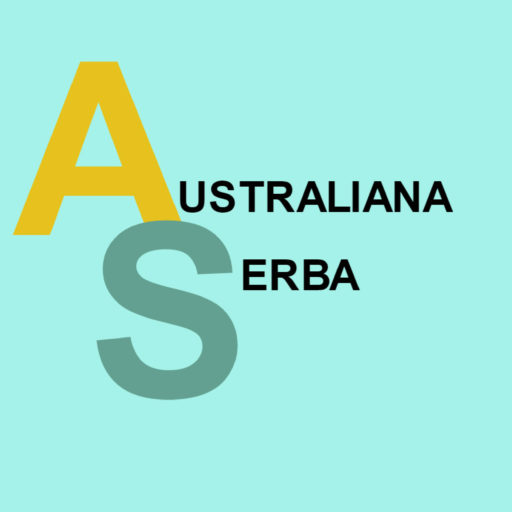


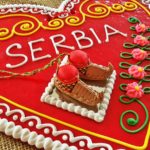

Leave a Reply